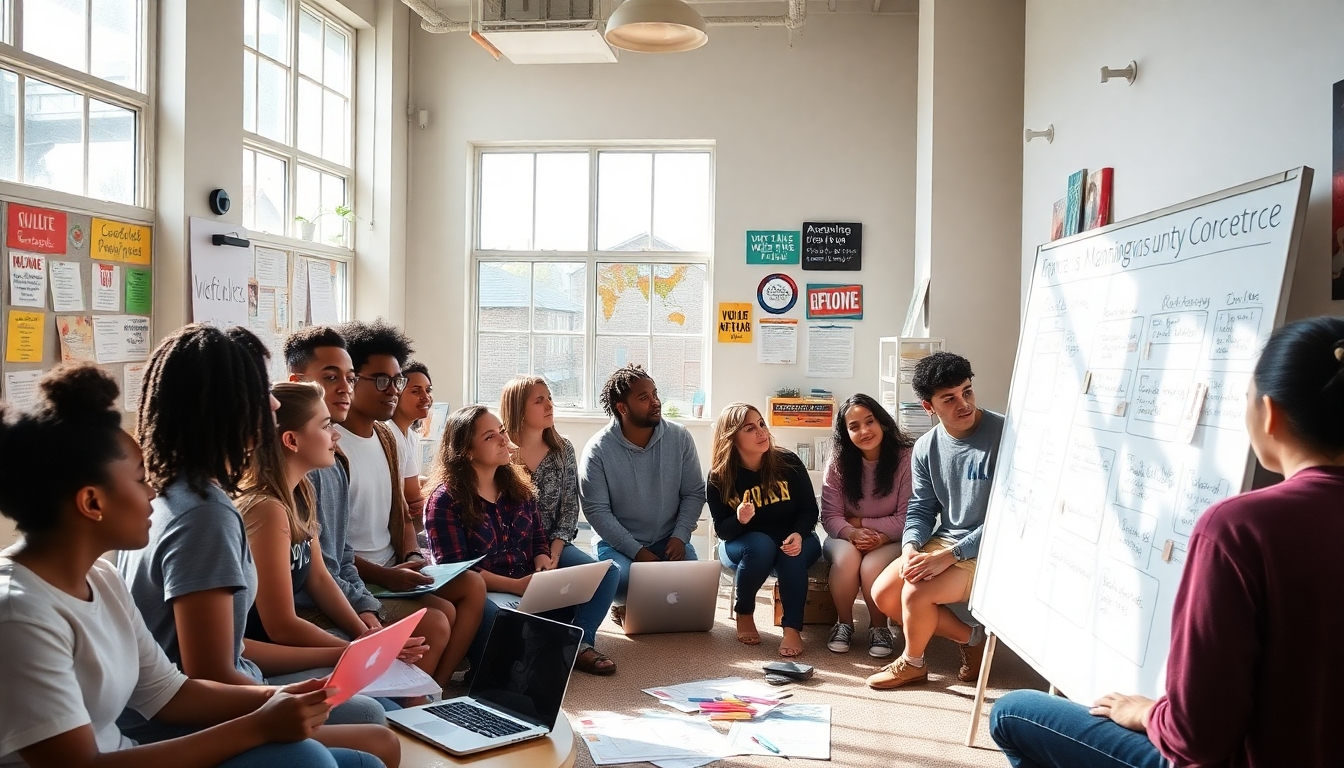Imagine a world where young voices are not just heard, but they lead the charge for change. That’s the magic of youth advocacy. It’s not just about speaking up; it’s about making waves and creating ripples that can transform communities and even the world. Picture the energy of a schoolyard—buzzing, vibrant, and full of potential. Now, channel that energy into advocacy, and you’ve got a force to be reckoned with.
Youth advocacy is like planting seeds today for a forest tomorrow. It’s about empowering young people to be the architects of their own future. Think of it as handing them the blueprints and the tools to build a better world. This isn’t just wishful thinking; it’s a necessary step to ensure that the concerns of the younger generation are part of the conversation when decisions are made. After all, who better to shape the future than those who will live in it?
But let’s not pretend it’s all sunshine and rainbows. Engaging the youth in advocacy is no walk in the park. It requires patience, commitment, and a willingness to listen. It’s about creating spaces where young people feel safe and valued, where their ideas are not just heard but acted upon. It’s about mentorship—guiding them without overshadowing their voices.
So, why is youth advocacy so vital? Because when young people are given a platform, they don’t just talk; they act. They bring fresh perspectives and innovative solutions to age-old problems. They are the catalysts for change, and with the right support, they can move mountains. The future isn’t just something that happens; it’s something we create. And with youth advocacy, we’re building a future that’s not just bright but brilliant.
Why Youth Advocacy is Critical for the Future
Have you ever wondered why the voices of young people matter so much? It’s because today’s youth are tomorrow’s leaders. They bring fresh perspectives and innovative ideas that can shape a better future for all of us. Youth advocacy is like planting seeds of change. When nurtured, these seeds grow into mighty trees that can transform entire landscapes.
Imagine a world where decisions are made without considering the needs and dreams of the younger generation. Scary, right? That’s why youth advocacy is essential. It ensures that the concerns and aspirations of young people are heard and included in important decision-making processes. This isn’t just about giving them a voice; it’s about valuing their insights and recognizing their potential to drive societal change.
But how do young people make such a big impact? Well, they are often more in tune with modern challenges like climate change, digital innovation, and social justice. They see the world through a different lens, unburdened by outdated norms. When they speak up, they bring energy and passion that can light up even the darkest corners of society.
In a nutshell, youth advocacy is about empowering the next generation to take charge of their future. It’s about creating a world where their ideas are not just heard, but acted upon. So, let’s support and encourage young advocates. After all, they’re not just the leaders of tomorrow—they’re the changemakers of today.
How to Get Young People Involved in Advocacy
Getting young people involved in advocacy is like planting seeds for a brighter future. But how do you get them to care? How do you make them feel like they have a voice? It’s simpler than it sounds. Start with education. Show them the issues that matter. Teach them about the world around them. Make it relatable. Remember, they are the future, and they need to understand the stakes.
Mentorship is another powerful tool. Think about it. Who doesn’t need a little guidance now and then? Young people thrive when they have someone to look up to. Someone who believes in them. Connect them with mentors who can share their experiences and wisdom. This not only inspires them but also gives them a roadmap for their advocacy journey.
And then there’s the power of platforms. Young people today are digital natives. They live online. So, give them spaces where they can express their thoughts and ideas. Social media, blogs, podcasts—these are their playgrounds. Encourage them to use these platforms to spread their message far and wide.
Finally, let’s not forget the importance of community. Young advocates need to know they are not alone. They should feel part of something bigger. Encourage them to join or create advocacy groups. This fosters a sense of belonging and amplifies their voices. After all, a single voice can be powerful, but a chorus of voices can be unstoppable.
Top Youth-Led Advocacy Movements Worldwide
When it comes to making waves in the world, young people are at the forefront of change. Their energy and passion often spark movements that ripple across the globe. One of the most remarkable examples is the Fridays for Future movement. Started by a single student, Greta Thunberg, who sat outside the Swedish parliament demanding climate action, it has grown into a global phenomenon. Students worldwide now skip classes on Fridays to demand a sustainable future, proving that even a lone voice can inspire millions.
Another noteworthy movement is the March for Our Lives, which emerged from the tragic school shooting in Parkland, Florida. Young survivors took their grief and turned it into a powerful campaign against gun violence. Their rallies drew hundreds of thousands, showing that youth voices can be a potent force for policy change. This movement is a testament to the resilience and determination of young people facing adversity.
In Asia, the Hong Kong Protests have seen young activists leading the charge for democracy and freedom. Their bravery and persistence in the face of immense pressure highlight the role of youth in advocating for political change. These movements, though diverse in their causes, share a common thread: the ability of young people to challenge the status quo and demand a better future.
These examples are just the tip of the iceberg. Across continents, youth-led movements are tackling issues like education, racial equality, and digital privacy. Their voices are not just echoes; they are the thunder that heralds change. The future belongs to these young advocates, and their impact is undeniable. Through their actions, they remind us that age is just a number when it comes to making a difference.
Tools and Resources for Young Advocates
When it comes to advocacy, having the right tools and resources can make all the difference. For young advocates, these tools can transform dreams into reality, turning whispers into roars. But what exactly do young changemakers need in their toolkit?
First off, **education** is key. Knowledge is power, right? Young advocates should dive into books, articles, and online courses that cover the topics they’re passionate about. Understanding the ins and outs of their chosen issue gives them credibility and boosts their confidence. It’s like having a map when navigating a new city.
Next, let’s talk about **mentorship**. Having a mentor is like having a guide who’s already climbed the mountain you’re about to tackle. They can offer insights, share experiences, and provide a shoulder to lean on when the going gets tough. Mentors can be found in community organizations, online forums, or even through school programs.
Now, onto **networking platforms**. Social media and online communities are powerful allies. They allow young advocates to connect with like-minded individuals, share ideas, and gain support. Platforms like Twitter, Instagram, and Facebook can amplify their voices, reaching audiences far and wide. But remember, it’s not just about shouting into the void; it’s about engaging in meaningful conversations.
Lastly, let’s not forget **funding opportunities**. Many organizations offer grants and scholarships specifically for youth-led initiatives. These funds can help turn ideas into action, whether it’s starting a community project or organizing a local event. It’s like having the fuel needed to keep the advocacy engine running.
In a nutshell, young advocates need a blend of education, mentorship, networking, and funding to truly make an impact. With these resources at their fingertips, they’re not just participants in the world—they’re active, empowered changemakers ready to shape the future.
Overcoming Barriers in Youth Advocacy
Let’s face it, being a young advocate isn’t always a walk in the park. There are challenges. Big ones. But that’s what makes it exciting, right? It’s like climbing a mountain. The view from the top makes the climb worth it. Young advocates often face hurdles such as lack of resources, limited access to decision-makers, and sometimes even skepticism from adults. But here’s the thing: every barrier is just an opportunity in disguise.
One of the biggest challenges is the lack of resources. Many young advocates don’t have the funding or tools they need to make their voices heard. But creativity knows no bounds. With the internet at your fingertips, a simple social media campaign can have a massive impact. Remember, the pen is mightier than the sword, and a tweet can be mightier than a billboard!
Another common barrier is the limited access to decision-makers. Young people often find themselves excluded from the rooms where decisions are made. But don’t let that stop you. Start small. Attend local meetings, join youth councils, or even start a petition. It’s all about building a bridge to those decision-makers, one step at a time.
Then there’s the skepticism from adults. Sometimes it feels like you’re shouting into the void. But persistence is key. Share your stories, your successes, and your struggles. People connect with authenticity. And when they see your passion, they’ll listen.
In the end, overcoming barriers in youth advocacy is about resilience, creativity, and a little bit of stubbornness. So, keep pushing. Because every step you take is a step towards a better future.
Frequently Asked Questions
- What is youth advocacy?
Youth advocacy is all about empowering young people to become active participants in shaping their communities and the world at large. It’s like giving them a megaphone to voice their ideas, concerns, and solutions. Through advocacy, young individuals can influence policies and drive changes that matter to them.
- Why is youth advocacy important?
Youth advocacy is crucial because it ensures that the perspectives of the younger generation are included in decision-making processes. Think of it as planting seeds for a better future; young advocates bring fresh ideas and innovative solutions to the table, which are essential for societal progress.
- How can young people get involved in advocacy?
Getting involved in advocacy can start with something as simple as joining a local group or online community. Education, mentorship, and access to platforms where they can share their voices are key. It’s like learning to ride a bike; with the right support and tools, young people can pedal their way to impactful advocacy.
- What are some successful youth-led advocacy movements?
There are numerous inspiring youth-led movements worldwide, from climate change initiatives to social justice campaigns. These movements showcase the power of young advocates who rally together, much like a band of superheroes, to tackle issues and bring about positive change.
- What tools and resources are available for young advocates?
Young advocates can benefit from a variety of tools and resources, including workshops, online courses, and mentorship programs. These resources act like a toolbox, equipping them with the skills and knowledge needed to effectively champion their causes.
- How can young advocates overcome barriers in advocacy?
Overcoming barriers in advocacy often involves persistence, creativity, and collaboration. By building networks and seeking guidance from experienced mentors, young advocates can navigate obstacles like a skilled sailor steering through a storm, ensuring their voices are heard.

